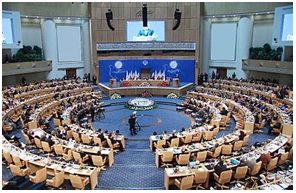Active Non-Alignment
Context: At the recently-held Munich security conference, a major concern of the members of the North Atlantic Treaty Organization (NATO) was the reluctance of the Global South to align itself with the G-7 on the war in Ukraine. Although the vast majority of countries across the world condemn the Russian invasion and would like the war to come to an end, very few countries in Asia, Africa and Latin America support the political and economic sanctions on Russia imposed by the G-7.
Third World on Ukraine war
- The developing world, and especially Africa, Asia and the Middle East/West Asia, has been the site of many wars, including those of the proxy kind, in the course of the past 70 years.
- None of them was elevated to the category of a unique war that demanded a global involvement to bring it to an end.
- Suddenly, a war erupts in Europe, and this means that all bets are off, and all countries should chip in to support Ukraine.
- As an Indian external affairs minister pointed out, Europe has to grow out of its mindset that Europe’s problems are the world’s problems, but the world’s problems are not Europe’s.
- Unable to come to terms with the fact that developing nations are unwilling to wage economic war against Russia, northern leaders are quite at a loss as to what to do.
- A recent call by Ukraine’s President to African leaders to meet with him over a teleconference turned out to be a fiasco: only four out of 55 showed up.
- The Foreign Minister of Ukraine has gone so far as to call on the Latin American and Caribbean nations to leave behind their so-called neutrality and put themselves on the right side of history.
Why these countries are choosing neutral stand?
- As the international system undergoes major shifts and we find ourselves on the verge of a second Cold War, this time between the U.S. and China, the last thing developing nations need to do is to take sides, allowing themselves to become “the plaything of others” to use Jawaharlal Nehru’s famous phrase.
- It is in this context that the concept of Active Non-Alignment (ANA) has come to the fore.
- ANA originated in 2019 and was developed in 2020 in response to the U.S.-China struggled for primacy, in which Latin America was caught in the middle.
- It was a bit of a manifesto calling for Latin American countries not to give in to pressures from either Washington or Beijing and to stick to their own interests.
- It took a page from the honourable tradition of the Non-Aligned Movement (NAM), but adapted it to the imperatives of the new century, impelled by the urgency of the Latin American crisis.
- And the key word is “active”. It is easy to do as you are told. It is much more challenging to embrace agency and come up with a fine-tuned and sophisticated diplomacy that looks at issues on a case-by-case basis.
- As it turns out, more than a future-oriented proposal, it is an approach that is already being applied in practice.
- Latin American governments had no difficulty in participating one week in December 2021 in the China-Community of Latin American and Caribbean States (CELAC) ministerial forum in Mexico City, and the next one in the Democracies Summit in Washington DC, seeing no contradiction in doing so.
India’s difficult balancing act
- India has taken a clear stand of non-alignment on the war, despite its closer ties with the U.S. in recent years, and its membership in the Quadrilateral Security Dialogue.
- As host and chair of this year’s G-20, India is managing the difficult balancing act of keeping this important informal group of developed and developing nations, that was instrumental in handling the 2008-09 financial crisis, on a steady course, despite the tensions this entails, as became evident in the G-20 Finance Ministers meeting held in Bengaluru recently.
- Seventeen African countries abstained in the United Nations General Assembly vote to condemn the Russian invasion of Ukraine. And South Africa, the African continent’s most developed economy, took this independence from the G-7 one step further by scheduling a naval exercise with the Russian Navy and also China off the country’s Indian Ocean coast that was held close to the very anniversary of the Russian invasion of Ukraine.
| Practice Question
1. Differentiate between the principle of Active Non-Alignment and Strategic Autonomy? |




